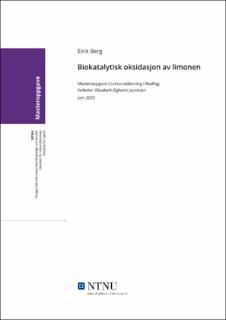Biokatalytisk oksidasjon av limonen
Master thesis
Permanent lenke
https://hdl.handle.net/11250/2785416Utgivelsesdato
2020Metadata
Vis full innførselSamlinger
- Institutt for kjemi [1399]
Sammendrag
I denne litteraturstudien diskuteres ulike oksidasjoner av limonen katalysert av en rekke biokatalysatorer. Fokuset er spesielt på biotransformasjoner katalysert av cytokrom P450 enzymer, både som rene, isolerte enzymer, og i helcellesystemer. Bruk av α-terpineol dehydratase, klorperoksidase og et pepperrotperoksidase/glukoseoksidase-system diskuteres kort. Videre er muligheten for å bruke «the peroxidase shunt», hvor kostbart og sensitivt NAD(P)H erstattes av hydrogenperoksid eller organiske peroksider, diskutert, så vel som ulike løsningsmiddelsystemers effekt på isolerte enzymer og helcellesystemer. Potensialet i genmodifiseringsteknikker som dirigert evolusjon og rasjonelt protein design for å endre enzymer, diffusjonskanaler og yttermembranproteiner omtales også kort. In this literature study oxidations of the cheap mono terpene limonene catalysed by different biocatalysts in order to produce valorised oxygenated limonene derivates are reviewed and discussed. Oxidations catalysed by enzymes from the cytochrome P450 superfamily, as isolated enzymes or in whole cell systems, are of particular interest, but oxidations by α-terpeniol dehydratase, chloroperoxidase and a horseradish peroxidase/glucose oxidase system are also discussed. Furthermore, the “peroxidase shunt”, in which hydrogen peroxide or organic peroxides acts as oxygen donors in the catalytic cycle of cytochrome P450 enzymes presents an opportunity to avoid the use of the expensive and sensitive cofactor NAD(P)H, is discussed. The effect of various solvent systems and immobilization techniques on isolated enzymes and whole cells is also mentioned. Lastly, the great potential in genetically altering enzymes, diffusion channels and outer membrane proteins through rational protein design and directed evolution is also discussed breifly.
